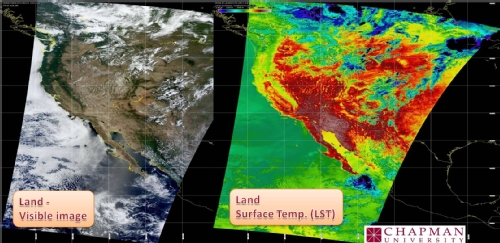Our newest and very exciting addition to the Institute for Earth, Computing, Human and Observing is the Orbital Systems 2.4XLB, Direct Broadcast (DB) Reception System. This antenna reception system automatically and accurately tracks X and L-band satellites, like NASA’s X-band Terra and Aqua MODIS, the European Space Agency’s L-band MetOp EPS, NOAA’s POES HRPT, and China’s Feng Yun 1D CHRPT, in order to receive earth observation data for science and weather research.
Some of the types of data we receive, process, and analyze are: Fire Mask, Normalized Difference Vegetation Index (NDVI) and Enhanced Vegetation Index (EVI), Sea Surface Temperature (SST), Chlorophyll-a Concentration, Cloud Mask, Aerosols, Cloud Top Properties and Cloud Phase, Atmospheric Profiles, Land Surface Temperature (LST) and Corrected Reflectance (CREFL). We incorporate the processed data into our Weather and Wave Forecasting models, Regional Atmospheric Modeling System (RAMS), and Wave Analysis Model (WAMS), respectively.

XL Band DB Reception System

Satellites tracked by the XL Band DB Reception System Antenna

Visible light and land surface temperature image products acquired by XL Band DB Antenna

Vegetation greeness index (NDVI) and Sea Surface Temperature image products of Antenna
A MODIS DB ground system consists of the following elements:
- A 3.0- meter EOS Tracker Earth Station with a 15’ space frame ESSCO radome
- A Dell PowerEdge 1900 2.0GHz Quadcore Xeon Linux server
- A 500 GB RAID disk storage and a DLT storage system
- Global Imaging software for data ingest, and
- NASA EOS DB software for data processing through Level 1B.
The receiving system electronics consists of a single integrated LNA/Feed and Downconverter and one Global SCSI Ingest (GSI) Unit. The GSI unit contains a MODIS receiver card and a Universal Multi-Satellite (UMS) bit/frame synchronizer. Global Imaging manufactures the receiver, the bit/frame synchronizer, and the SCSI chassis in which they reside. A single cable carrying both signal and power connects the receiver to the integrated feed/downconverter.
The MODIS receiver features QPSK/BPSK/PSK demodulation. The receiver is a versatile unit that was designed for the next generation of weather satellites. The receiver offers built-in Viterbi, selectable RF inputs and bandwidths, frequency control, Doppler tracking, and Q and I baseband output signals.
The Global Imaging UMS bit/frame synchronizer is an advanced universal multi-satellite synchronizer. The UMS synchronizer accepts bit rates up to 30 mbps and supports CCSDS, NRZ-L, M, S, and Bi-phase L, M, and S inputs. NESDIS uses our UMS synchronizer equipment in the Advanced Front EndProcessor (AFEP), which ingests GOES and POES data for processing and distribution to all US National Weather Services offices.
Satellites from which we are downloading data: Terra, Aqua, NOAA13, NOAA18, NOAA19, FY1D, METOP
RAMS is a highly versatile numerical code for simulation and forecasting meteorological phenomena, and for depicting the results. Its major components are:
- An atmospheric model that performs the actual simulations
- A data analysis package that prepares initial data for the atmospheric model from observed meteorological data
- A post-processing visualization and analysis package that interfaces atmospheric model outputs with a variety of visualization software utilities. It is fundamentally a limited-area model, but may be configured to cover an area as large as a planetary hemisphere for simulating mesoscale and large-scale atmospheric systems.
The wave forecasting performed by our group is based on the ECMWF parallel version of WAM (CYCLE 4) model. It is a third-generation wave model that computes spectra of random short-crested wind-generated waves and is one of the most popular and well-tested wave models worldwide (ECMWF, UK Met Office, US Navy, etc.). The resolution used (0.2 – 0.1 degrees) is the finest used today for the North Pacific Ocean, and this is the first wave model that solves the complete action density equation, including non-linear wave-wave interactions.
Chapman University has a high-performance computer linux (Centos 5.2) cluster consisting of 2 master nodes and 12 computing nodes for a total 192 CPUs. The current operational usage is for an operational high resolution atmospheric model called RAMS (www.atmet.com) for the area of LA and OC and results are can be seen at: http://forecast.chapman.edu, and a high resolution ocean wave operational model named WAM result are in the webpage: http://forecast.chapman.edu/wave.php. The cluster is also been used for research projects such as: http://chapmannews.wordpress.com/2011/05/26/schmid-college-wins-major-grant-to-study-climate-change-impact-on-california-agriculture/ and for educational purposes for students that are related to environmental and bioinformatics.
The hardware configuration for each master node is Dual socket Xeon Quad-Core processor, 2.26 GHZ, 8GB L2 RAM, 3-5 SATA drives in RAID configuration (5TB HDD), DVD RAM. The configuration for each compute node is Dual socket Xeon Quad-Core processor, 4GB RAM, 1 SCSI drive (~250GB HDD), DVD RAM. A file server with 10TB storage capacity, a color laser printer and a regular desktop (Quad-core, 4GB RAM, 1TB HDD, DVD-RAM), and two 1.5TB external drives to keep backup of the master and compute nodes are also included in the system. A central net switch and one 24port 10/100Mbps + 1000Mbps smart switch with 4 Gigabit Ports will connect the compute nodes with the master nodes. A power back-up UPS system (5×4=20KVA capacity) is also needed to avoid any loss of data. Arrangements of cooling and AC power lines required for the cluster would be made through Chapman University’s Utility Services.
Operating Systems: Dual boot with Linux (CentOS 5 64bit and Windows XP 64bit)
Software: Office 2007, Matlab 2009, ArcReader 9.3.1f, ILWIS 3.6.01, Cygwin, HDF Explorer, GMT, HDFView, R, GrADS, Google Earth, Filezilla, Singular CAS, ArcReader (arcgis), xming, putty, Filezilla, Google earth, HDF explorer, ILWIS, MatLab(R2011a), MsOffice 2010, Picasa, R 2.9.1 foundation for statistical computing, Singular CAS


